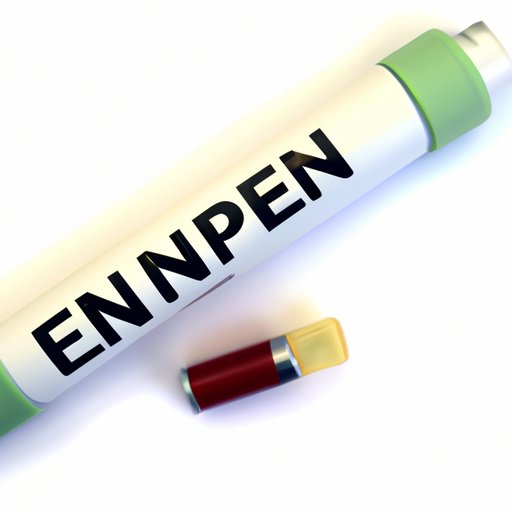
I. Introduction
An epipen is a life-saving medication administered to individuals experiencing anaphylaxis, a severe allergic reaction that can be fatal without prompt treatment. In this article, we will provide a comprehensive guide on how to use an epipen, the urgency of using it during an anaphylactic emergency, tips for maintaining and storing epipens, common mistakes to avoid when using them, and how to help someone else use an epipen. Read on to learn more about how to manage anaphylaxis and safely administer an epipen.
II. Step-by-Step Guide for First-Time Epipen Users
Preparation is key to successfully administering an epipen. Before administering it, remove the blue safety cap and check the expiration date of the medication. With the patient’s thigh exposed, hold the epipen at a 90-degree angle and apply it to the middle of the outer thigh. Firmly press the pen against the thigh for several seconds to release the medication. Finally, hold the injection site for at least ten seconds.
III. Understanding the Urgency of Using an Epipen During Anaphylaxis
Anaphylaxis is a serious allergic reaction that can cause difficulty breathing, swelling, hives, and a drop in blood pressure. Epipens are necessary in the event of an anaphylactic emergency because they contain epinephrine, a medication that can help reverse anaphylaxis. It’s crucial to use epipens promptly to prevent severe complications or death.
IV. Tips for Maintaining and Storing Your Epipen
Proper storage of the epipen is important to ensure its effectiveness when needed. It should be stored away from direct sunlight in a cool, dry place. Check the expiration date regularly and replace expired epipens promptly. When carrying the epipen with you, avoid exposing it to extreme temperatures or sunlight. Consider purchasing a holder for the epipen to keep it safe while carrying it.

V. Common Mistakes to Avoid When Using an Epipen
One of the most common mistakes people make when using an epipen is delaying use. Epipens should be used as soon as anaphylaxis symptoms are noticed, without waiting for more severe symptoms to develop. Additionally, it’s important to use the right injection technique, holding the pen at a 90-degree angle and applying it to the thigh firmly for several seconds. Finally, seeking medical attention is critical after injecting the epipen. Anaphylaxis can recur, meaning patients need in-hospital care even after the initial treatment with the epinephrine epipen.
VI. Preparing for an Allergic Reaction: Knowing When to Use an Epipen
Identifying triggers and knowing the symptoms of an allergic reaction are important steps in preparing for an anaphylactic emergency. Work with your doctor or allergist to create an action plan for managing anaphylaxis. Be aware of situations where an allergic reaction may be more likely, such as during exercise or when eating certain foods.
VII. How to Help Someone Else Use Their Epipen in an Emergency Situation
If someone you’re with has an anaphylactic emergency and you need to administer their epipen, it’s important to obtain their consent first. Identify anaphylaxis symptoms in others, which may include wheezing or difficulty breathing, swelling, and low blood pressure. Hold the epipen at a 90-degree angle and firmly apply it to their thigh for several seconds before seeking emergency medical attention.
VIII. Answering Frequently Asked Questions about Epipen Use and Administration
Can epipens be reused? No, epipens are single-use and should be disposed of after each use.
Can you give an epipen to someone who doesn’t have a prescription? No, epipens are prescription medications and should only be administered to individuals with a known history of anaphylaxis and a valid prescription for an epipen.
Are there any side effects of using an epipen? Common side effects of using an epipen include a fast heart rate, sweating, and shakiness. These side effects typically resolve quickly and are not serious.
IX. Conclusion
An epipen is a life-saving medication for individuals at risk of anaphylaxis. Knowing the correct administration techniques, understanding the urgency of prompt use, and being prepared for an emergency can save a life. Remember to seek medical attention after administering an epipen, as further treatment may be necessary. Finally, emphasizing the importance of being aware of the risks of anaphylaxis, and working with your doctor to develop an action plan and carry an epipen at all times can be lifesaving.




